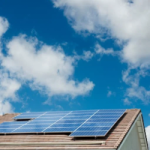Could listed homes jump on the solar panel bandwagon?
With one London borough getting set to allow solar panels on listed buildings, could this be a trend that will be copied across the country, as local authorities continue their bid to become carbon neutral?
Solar Panels on Listed Buildings
Thanks to the current energy crisis and rising inflation, more and more of us are looking at ways to cut our electricity bills – and one method to consider is investing in solar panels.
If you install solar panels on your home (assuming you have a roof that points in the right direction to capture enough sunlight to make it worthwhile), you can save cash in two ways. You can use the electricity you generate, so it costs you nothing but your investment and, subject to the amount you generate, you can sell back the electricity you don’t use to the National Grid.
So if you have savings, investing in panels – which can cost upwards of around £6,000 – could help you see a reasonable return on your money. You may also be able to buy them using a low-interest instalment scheme.
Permitted Development
The other good news is that solar panel installation comes under the Permitted Development rules, so you don’t need to get planning permission, subject to satisfying specific criteria – The Town and Country Planning (General Permitted Development) (England) Order 1995 (as amended), Schedule 2, Part 14, Class A. In Conservation Areas the rules are more stringent, but it is still possible to install them using Permitted Development rights. However, this does not apply where the property is a listed building. In this instance, you have to apply for planning permission and listed building consent – and it is only granted at the discretion of the local authority.
However, one London borough is looking to change that – and is considering allowing listed homes to install solar panels without applying for permission.
Local Listed Buildings Consent
Kensington and Chelsea Council estimates that 80% of the borough’s carbon emissions come from buildings and it hopes that a new policy will make an impact. It is the first to introduce a Local Listed Buildings Consent Order that will mean listed building consent is no longer required not only for solar panels but also solar tiles or slates on most Grade II and II* buildings. The order only applies to domestic buildings – it will not apply to any non-residential listed buildings.
It’s no free-for-all though, as there are conditions attached to factors such as positioning, materials and fittings – but the council maintains that it will only require a simple application. The move is being considered in a bid to ensure the borough is carbon neutral by 2040. The plans for the order went to consultation in February, and have been supported by the Historic Houses Association, local individuals and residents’ associations.
Levelling Up
It’s an interesting proposal, and it will be interesting to see if other councils across the country will seek to follow the example. It certainly will appeal to them as they strive to become carbon neutral – and adhere to the ethos of the recent government white paper Levelling Up, which aims to help streamline the planning process further.
But will it be at too high a cost? Will the requirements be so restrictive when it comes to special materials and fixings, that it will be out of reach of your average homeowner? In an affluent borough like Kensington and Chelsea, one could argue that there will be sufficient wealth to pay for these special considerations, but will that be true across the country?
And if the requirements are not restrictive enough, will the installation of panels create a visual clutter that spoils the very aesthetics of historic buildings that listing is supposed to protect? The proposed order does state that the panels must be: ‘sensitively designed and positioned on the building so that they would not have a harmful visual effect on the building itself or the wider area.’ However, it uses language such as “so far as is practicable” to determine how and where the panels are installed, which arguably leaves a lot to subjective interpretation and uncertainty. It will be interesting to see whether local authorities decide that it will be an effective way forward and a price worth paying when it comes to reducing fossil fuel energy consumption.
If you would like to discuss your own project with us, or just find out more about what we do, please continue to browse the website or drop us an email to: info@apexplanning.co.uk without obligation.

